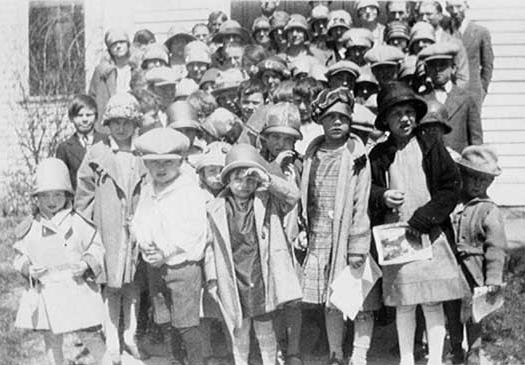
United States Boys' Headwear: Conventions

Figure 1.--One of the conventions associated with headwear is formality. This looks like an American Sunday School group, we think in the 1920s. Notice that almost all of the children are wearing headwear. The boys wear the ubiquitous flat cap. The girls wear the helmet-like hats that were popular at the time. .
|
|
Men and boys both wore caps and hats and there were a variety of conventions associated with their headwear. Age was an important factor. Formality was an important factor. Headwear was more common in the 19th than 20th century, byt it was especially common for formal occassions. Thus we see headwear more commonly for church or other special occassions than for play. This of course varied over time. Children once dressed up to go to school which meant wearing headwear. As schoolwear became more casual, children less commonly wore headwear to school. Seasonality was another facor. There were also various styles of cold weather caps. There were also summer styles like sun hats and wide-brimmed sailor hats. Other caps were worn year round. We note peaked caps and flat caps in the early 20th century. Headwear was also worn for sports and casual occassions. became less common after World War II, but baseball caps eventually became fashion statements.
Age
Age was an important factor. We see some headwear styles that were made mostly for children. Age appropriate headwear seems most common in the 19th century, but we also notice it in the early-20th century. We also notice boys wearing headwear styles that were worn by adult men. We see this on both the 19th and 20th century.
Formality
Formality was an important factor in the choice of headwear. Chronology was a complicating factor as popular attitudes toward formality changed over time. And we do not have a complere picture of the 19th century because the snapshot showing casual, informal life only appeared in large numbers after the turn-of-the 20th century. We do not that very often children in the formal 19th century studio portraits had headwear, often on a nearby table or on the ground. Headwear was more common in the 19th than 20th century, but it was especially common for formal occassions. Hats seem to have generally been see as more formal than caps, but both age and social class were factors here. Most headwear was purchases separately from the suit or other outfits purchased for children. Some suits even had headwear especially made to match. This almost always was a cap, commonly a peaked cap. We see headwear more commonly for church or other special occassions than for play. Of course for children this commonly meant sunday school. This of course varied over time. Children once dressed up to go to school which meant wearing headwear. As schoolwear became more casual, children less commonly wore headwear to school.
Seasonality
Seasonality was another facor. There were also various styles of cold weather caps. There were also summer styles like sun hats and wide-brimmed sailor hats. Other caps werre worn year round. We note peaked caps and flat caps in the early 20th century.
Seasonality
Headwear was also worn for sports and casual occassions. became less common after World War II, but baseball caps eventually became fashion statements.
HBC

Navigate the Boys' Historical Clothing Web Site:
[Return to the Main U.S. headwear page]
[Return to the Main U.S. country garment page]
[Introduction]
[Activities]
[Biographies]
[Chronology]
[Clothing styles]
[Countries]
[Bibliographies]
[Contributions]
[FAQs]
[Glossary]
[Images]
[Links]
[Registration]
[Tools]
[Boys' Clothing Home]
Created: 6:18 PM 1/20/2007
Last updated: 3:16 AM 6/18/2007



